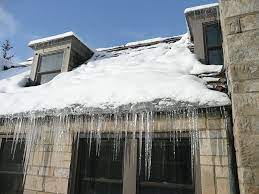Widgetized Section
Go to Admin » Appearance » Widgets » and move Gabfire Widget: Social into that MastheadOverlay zone
How can homeowners in the Vail Valley safely fix ice dams this coming winter

When winter rolls around, homeowners in the Vail Valley often dread the formation of ice dams. Ice dams are caused when water from your roof’s shingles and other parts of your roof seeps into your attic. When this water freezes, it expands, which causes ice to build up on your roof. This can cause serious problems, including water damage, mold, and possibly even structural damage to your home.
Luckily, you can do a few things to prevent ice dams from forming in the first place. So, the following information will discuss what ice dams are and how homeowners in the Vail Valley can fix them.
Why are Ice Dams So Common in the Vail Valley?
The Vail Valley is renowned for its beautiful snow-capped peaks, cool weather, and winter sports. However, all of this fun comes with a few drawbacks.
Vail Valley homeowners are very susceptible to ice dams caused by nonuniform temperatures on their roofs. Ice dams are further exacerbated by heat loss from your home, outdoor temperatures, and snow cover.
Therefore, it’s important to note that for an ice dam to form, your roof must be covered by snow, and the higher portions of the roof must have surface temperatures greater than 32 degrees Fahrenheit. When these conditions are present, the snow will melt in the warmer areas and drain to the colder areas, where it will refreeze. This thawing and refreezing process leads to a buildup of liquid behind the ice dam that can seep through cracks and crevices in your roof.
Why is it important to prevent ice dams?
The Vail Valley receives a lot of snow in the winter, and while icicles and snow drifts are beautiful, they can lead to some problems for your home.
Ice dams can loosen shingles, tear off gutters, and eventually lead to water damage. When this occurs, the results are often not good: warped floors, sagging and stained ceilings, peeling paint, etc. Perhaps the worst part is that the insulation in your attic can get wet, which can lead to the growth of mildew and mold.
Preventing Ice Dams in the Vail Valley
If you live in Vail Valley, then you already know that ice dams are just something that has to be dealt with in the winter. However, there are a few things that you can do to prevent them from forming in the first place.
Here are some things you can do:
- Although the Vail Valley doesn’t have as much foliage as areas like Hagerstown, MD, you should still regularly clean the sticks, leaves, and debris from your gutters and downspouts. This will not only allow the water from melted snow to flow easier, but it can also reduce your risk of fires in the summertime.
- Take steps to keep the buildup of snow on your roof at a minimum. This can be done with the help of tools like a “roof rake.” These rakes have long handles that allow you to stand on the ground and rake the snow away from the roof.
- Try to keep all downspouts and gutters clear of ice and snow during the winter.
- Hire a professional to inspect the insulation and ventilation of your attic. It’s widely accepted that attic insulation with an R-value of at least R-38 is enough to prevent heat loss from your home.
- You can also install heated cables by attaching clips to the roof’s edge in a zigzag pattern. This solution works well because it equalizes the roof’s temperature by heating it from the outside rather than from the inside.
How can Vail Valley homeowners fix ice dams?
Ice dams need to be appropriately addressed. So, rather than hacking away using a chisel or shovel, which is dangerous for you and your roof, or throwing salt, check out our top suggestions below:
Use a Roof Rake
Long-handled roof rakes allow you to stand safely below and pull the snow off the roof. You may also want to check out the rakes that have wheels, as these can instantly change the roof’s exterior temperature without damaging the shingles.
Blow Cold Air
One of the fastest ways to take care of an ice dam is to place a fan in the attic. It will need to be pointed toward the area of your roof where it’s leaking, so the targeted cold air can refreeze the water and stop the leak.
De-ice It
Using a de-icer and pantyhose can also reduce further damage from an ice dam. Simply fill the stockings with an ice melter containing calcium chloride and lay it across the ice dam. If you’re having trouble getting it into place, use a long-handled garden hoe or rake to push it into position gently. Once in place, the calcium chloride begins to melt the ice and snow, creating a channel for the water to flow off the roof or into the gutters.
The Bottom Line
The best way to fix an ice dam is to address the source of the ice, which is typically an area of your roof where the insulation is poorly installed. You can also use a de-icer, blow cold air into the attic, and use a roof rake to remove snow and ice. You may need to call a professional if these options don’t work, but it’s worth the cost to prevent further damage to your roof and home.


